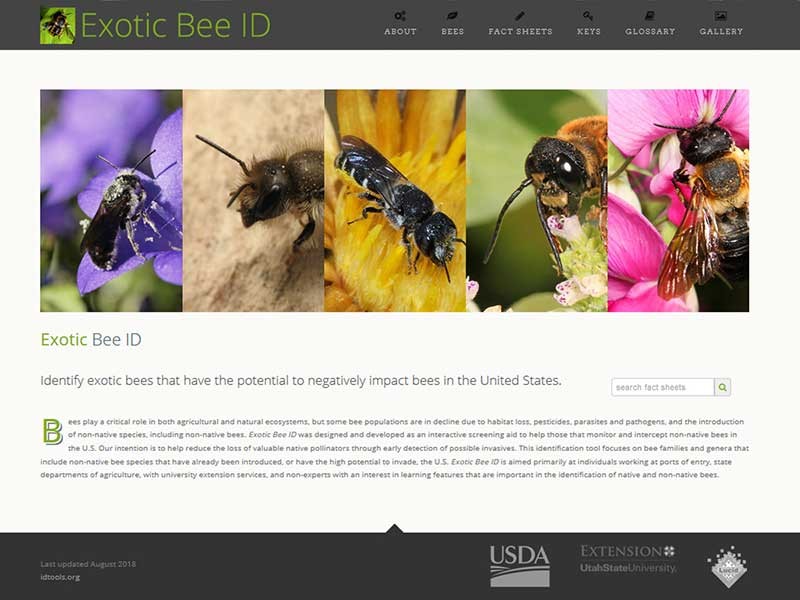USU, USDA Entomologists Create Exotic Bee Identification Tool
USU, USDA entomologists, l to r, Lori Spears, Skyler Burrows, Ricardo Ramirez, Terry Griswold and Morgan Christman created the USDA-funded Exotic Bee ID Guide. Team members not pictured are Allan Smith-Pardo, Steven Price and Amanda Redford.
Many bees nest in stems, twigs and crevasses, which makes them adept stowaways, says Utah State University entomologist Skyler Burrows. For this reason, customs officials and other managers monitor entry of non-native bee species, inadvertently shipped with imported produce and products through the nation’s many ports, with vigilance.
“Invasive species can cause declines in native bee populations through competition for food and habitat or introduction of pathogens and parasites,” says Lori Spears, professional practice assistant professor in USU’s Department of Biology. “Native bees are critical to both agricultural and natural ecosystems, so having screening tools to identify, monitor and intercept non-native bees is important.”
To that end, Burrows and Spears, along with USU and USDA Bee Lab colleagues Morgan Christman, Allan Smith-Pardo, Steven Price, Ricardo Ramirez, Terry Griswold and Amanda Redford created Exotic Bee ID, an online identification guide for the USDA Identification Technology Program.
The team received three, one-year grants totaling $447,915 from the U.S. Department of Agriculture-Animal and Plant Health Inspection Service-Plant Protection and Quarantine to fund the project.
“The identification tool is designed to aid non-entomologists in accurate identification of species, to help these managers better plan interventions,” Spears says. “Until now, few resources have been available for intercepting potentially harmful invasive species.”
The new guide includes instructions on bee specimen preparation, bee morphology illustrations, an illustrated glossary of terms, a filterable image gallery, searchable fact sheets and two interactive identification keys.
Though designed primarily for professionals working at ports of entry, state departments of agriculture and university extension agents, access to Exotic Bee ID is free and open to all.
The current release includes species that have already been introduced into the United States or have a high potential to invade.
“This tool is the first of three phases planned for Exotic Bee ID,” says Griswold, USDA research entomologist and adjunct assistant professor in USU’s Department of Biology.
Future releases, he says, will include keys, fact sheets and images for additional species in groups that have invaded the United States or are likely to arrive.
“As we continue to work on future releases, we’ll be able to zoom in on particular genera and provide more detail on selected species, based on their potential invasiveness.” Says Christman, a graduate student in USU’s Department of Biology.
View Exotic Bee ID at the following USDA-APHIS link.
Related Links
USU Department of Biology
USDA Pollinating Insects and Systematics Research Lab
USU Extension
USU College of Science
Contact: Lori Spears, 801-668-4056, lori.spears@usu.edu
Writer: Mary-Ann Muffoletto, 435-797-3517, maryann.muffoletto@usu.edu
The online Exotic Bee ID guide, created by USU and USDA entomologists, includes instructions on bee specimen preparation, bee morphology illustrations, an illustrated glossary of terms, an image gallery and two interactive identification keys.
TOPICS
Ecosystems 135stories Bees 27storiesComments and questions regarding this article may be directed to the contact person listed on this page.








